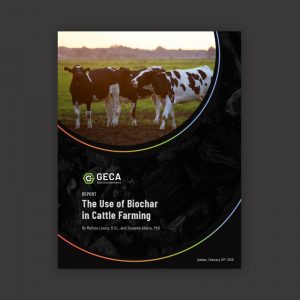Influence de la matière première et des méthodes de pyrolyse sur les propriétés reliées au carbone de biochars
$18.00
Article disponible en Anglais et en PDF seulement.
Auteurs: Suzanne E Allaire, Melissa Leung & Sébastien F Lange
Citation :
Allaire SE, Leung M, Lange S. 2020. Carbon-related properties of biochars influenced by feedstock and pyrolysis methods, with an emphasis on feedstocks from a cold climate. GECA Environnement, Québec, Canada, 41 p. doi: 10.13140/RG.2.2.21521.25440.
Résumé :
This report examines the relationships between carbon-related properties of biochars based on their production methods. Forty three biochars made from various plants and manures using various technologies and pyrolysis settings were used. The measured properties include total carbon, volatiles, graphitic-like carbon, organic carbon, inorganic carbon, O, H, H/C, O/C, ash contents and calorific value. This report further examines certain relationships between properties and contributes to our understanding of biochar variability, production and usage.
Overall, cold climate feedstock-derived biochars had properties similar to those of biochars made from similar feedstocks (hardwood, softwood, non-woody material, manure, etc.) and can easily compete with biochars coming from different climates based on their inherent quality.
The feedstock type, pyrolysis type (fast vs slow) and temperature greatly influenced most of the analyzed properties. The total carbon content was highly correlated to most of the other properties and, as it is usually one of the cheapest properties to measure, it could be used to roughly predict several other properties. The pyrolysis temperature was also strongly correlated with many properties and could potentially be used to predict other properties as well.
Based on estimated carbon stability, the studied biochars could be used as soil amendment, many of them for carbon sequestration and N2O emission reduction. Out of the 43 biochars examined, all of them could be used for energy purposes, but careful attention must be given to the ash contents.
Technology manufacturers and biochar producers as well as designers must know the relationships between biochar properties in order to predict product type and potential applications. General properties could be predicted from carbon content, pyrolysis conditions and biomass characteristics.




